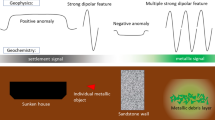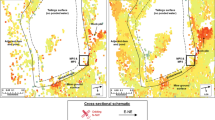Abstract.
Two alternative approaches are investigated to compute the discrete Stokes integral for gravimetric geoid determination so that geographical grid subdivision and gridding is not required. The techniques are based on Voronoi and Delaunay structures, in which the target area is partitioned into polygons and triangles, respectively, and the computation is carried out by point-wise integration. In the Voronoi scheme, polygonal areas just contain the observed gravity anomalies, instead of the interpolated ones; thus no gridding process or data interpolation is necessary, and only the original data are used. In the Delaunay scheme, gridding is also not required, but observed anomalies are interpolated into triangular compartments whose vertices hold the gravity stations. Geoidal undulations are thus computed at the barycenters (centroids) of the triangles. Both schemes were applied to the local gravimetric geoid determination in two distinct areas of Brazil (municipality of Rio de Janeiro, and Resende). The gravity observations are almost uniformly distributed spatially at both sites, and their topographies are very rugged. The Stokes component was also computed by means of classical numerical integration (space-domain), and compared with the Voronoi and Delaunay schemes to give root-mean-square (RMS) differences of 0.022 and 0.024 m, respectively, at the Rio de Janeiro site. In Resende, the comparisons yielded RMS differences of 0.040 and 0.053 m. The largest difference did not exceed 0.100 m for both methods and datasets. The one-dimensional (1-D) FFT (spectral domain) technique was also used on the Rio de Janeiro dataset, which gave RMS differences of 0.031 m for the classical method, 0.039 m for the Voronoi scheme, and 0.047 m for the Delaunay scheme. Relative comparisons with 465 GPS-leveling baselines in the Rio de Janeiro site gave RMS differences of 0.069, 0.061, 0.071, and 0.071 m, for the Voronoi, Delaunay, classical, and 1-D FFT methods, respectively. Since the Voronoi and Delaunay schemes avoid the gridding step, the pre-processing time and labor are reduced. As with other methods, the dependence upon data quality and distribution is the main drawback of both schemes. Finally, the Voronoi and Delaunay schemes proved to be computationally as efficient as the 1-D FFT method for only the geoid height computation.
Similar content being viewed by others
Acknowledgments.
The authors gratefully thank the unknown reviewers for their helpful suggestions, and Dr. W. Featherstone for his constructive remarks and contributions to the text.
Author information
Authors and Affiliations
Corresponding author
Rights and permissions
About this article
Cite this article
Santos, N., Escobar, I. Discrete evaluation of Stokes’s integral by means of Voronoi and Delaunay structures. Journal of Geodesy 78, 354–367 (2004). https://doi.org/10.1007/s00190-004-0402-5
Received:
Accepted:
Published:
Issue Date:
DOI: https://doi.org/10.1007/s00190-004-0402-5




